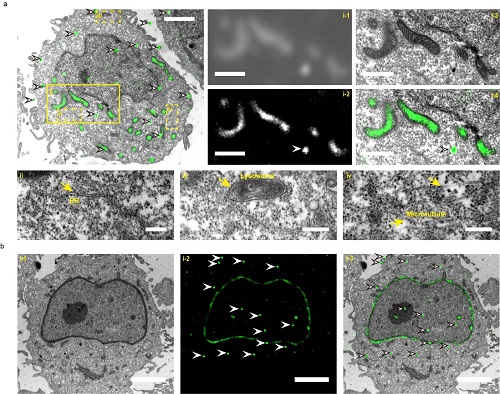
In a recent study published in in Nature Methods, a research team led by Dr. XU Tao and Dr. XU Pingyong from Institute of Biophysics of the Chinese Academy of Sciences developed the first photo-converted fluorescent protein mEosEM that remained fluorescence after routine EM preparation. The protein has photoswitchable property that are suitable for single molecule localization microscopy (PALM/STORM).
Protein molecules assemble into protein machinery at specific locations in the cell to perform biological functions. Electron microscopy (EM), a research tool, achieves sub-nanometer spatial resolution. Immunoelectron microscopy had been commonly used for this purpose by taking advantage of an antigen-antibody reaction.
Correlative light and electron microscopy (CLEM) is a powerful tool that combines the light microscopy (LM) for locating target molecules with high labeling efficiency and specificity, and EM for providing the ultrastructural of the cellular context. The recently emerged super-resolution CLEM (SR-CLEM) improves LM resolution beyond the diffraction limit and narrows the resolution gap between LM and EM.
For CLEM, osmium tetroxide (OsO4) fixation and Epon embedding for maintaining cellular ultrastructure and contrast and ensuring sectioning property during EM sample preparation inevitably quench fluorescence of fluorescent proteins (FPs). The pre-embedding CLEM method images the whole cell by LM before the fluorescence is destroyed by the subsequent EM sample preparation. However, precise image registration is not feasible due to the deformation of sample after EM sample preparation and unmatched Z-axial resolution between LM and EM.
Therefore, it would be of great benefit to develop a fluorescent protein that can retain fluorescence after OsO4-fixation and Epon-embedding.
By using mEosEM and optimizing the imaging acquisition method and the single molecule localization algorithm in ultrathin sections, the researchers achieved Epon-embedding-based SR-CLEM using the same-section approach for the first time, greatly promoting the field of SR-CLEM.
The developed FP and SR-CLEM method can well preserve the subcellular structure in EM, and also retain the localization accuracy of PALM. Intracellular mitochondria and nuclear membrane were successfully localized and correlated using this technique.
This study is expected to bring a wide range of applications in biology.

Epon-embedding-based SR-CLEM of mitochondrial and nuclear lamina A using the same-section approach (Image by Dr. XU Pingyong's group)

86-10-68597521 (day)
86-10-68597289 (night)

86-10-68511095 (day)
86-10-68512458 (night)

cas_en@cas.cn

52 Sanlihe Rd., Xicheng District,
Beijing, China (100864)

